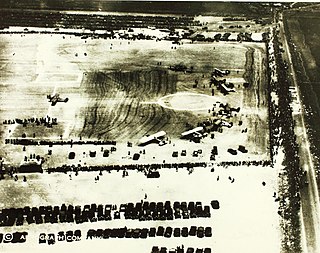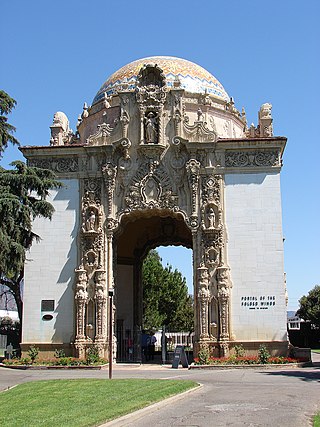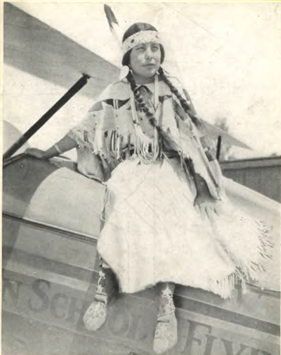
The La Fayette Escadrille was the name of the French Air Force unit escadrille N 124 during the First World War (1914–1918). This escadrille of the Aéronautique Militaire was composed largely of American volunteer pilots flying fighters. It was named in honor of the Marquis de Lafayette, French hero of the American Revolutionary War. In September 1917, the escadrille was transferred to the US Army under the designation 103rd Aero Squadron. In 1921, The French Air Force recreated a N124 unit who claimed lineage from the war-time La Fayette escadrille and is now part of the escadron 2/4 La Fayette.

The Orteig Prize was a reward offered to the first Allied aviator(s) to fly non-stop from New York City to Paris or vice versa. Several famous aviators made unsuccessful attempts at the New York–Paris flight before the relatively unknown American Charles Lindbergh won the prize in 1927 in his aircraft Spirit of St. Louis. However, a number of people died who were competing to win the prize. Six men died in three separate crashes, and another three were injured in a fourth crash. The Prize occasioned considerable investment in aviation, sometimes many times the value of the prize itself, and advancing public interest and the level of aviation technology.
Francis Herbert Goldsborough was a record-holding aviator who died in a plane crash in Vermont on his 20th birthday.

The Dole Air Race, also known as the Dole Derby, was a deadly air race across the Pacific Ocean from Oakland, California to Honolulu in the Territory of Hawaii held in August 1927. There were eighteen official and unofficial entrants; fifteen of those drew for starting positions, and of those fifteen, two were disqualified, two withdrew, and three aircraft crashed before the race, resulting in three deaths. Eight aircraft eventually participated in the start of the race on August 16, with only two successfully arriving in Hawaii; Woolaroc, a Travel Air 5000 piloted by Arthur C. Goebel and William V. Davis, arrived after a 26 hour, 15 minute flight, leading runner-up Aloha by two hours.

Eddie August Henry Schneider was an American aviator who set three transcontinental airspeed records for pilots under the age of twenty-one in 1930. His plane was a Cessna Model AW with a Warner-Scarab engine, one of only 48 built, that he called "The Kangaroo". He set the east-to-west, then the west-to-east, and the combined round trip record. He was the youngest certificated pilot in the United States, and the youngest certified airplane mechanic. He was a pilot in the Spanish Civil War in the Yankee Squadron. He died in an airplane crash in 1940, while training another pilot, when a Boeing-Stearman Model 75 belonging to the United States Navy Reserve overtook him and clipped his plane's tail at Floyd Bennett Field.

Bertrand Blanchard Acosta was a record-setting aviator and test pilot. He and Clarence D. Chamberlin set an endurance record of 51 hours, 11 minutes, and 25 seconds in the air. He later flew in the Spanish Civil War in the Yankee Squadron. He was known as the "bad boy of the air". He received numerous fines and suspensions for flying stunts such as flying under bridges or flying too close to buildings.

Robert Nietzel Buck broke the junior transcontinental air speed record in 1930 and for a time was the youngest licensed pilot in the United States.
Benjamin Odell Howard, was an American aviator and aeronautical engineer, whose aircraft won the Bendix Trophy and the Thompson Trophy in 1935.

Charles Albert Levine was the first passenger aboard a transatlantic flight. He was ready to cross the Atlantic to claim the Orteig prize but a court battle over who was going to be in the airplane allowed Charles Lindbergh to leave first.

The Portal of the Folded Wings Shrine to Aviation is in Los Angeles, California. The shrine is a 75-foot-tall (23 m) structure of marble, mosaic, and sculpted figures and is the burial site for fifteen pioneers of aviation. Designed by Kenneth A. MacDonald Jr. and sculptor, Federico Augustino Giorgi, it was built in 1924 as the entrance to Pierce Brothers Valhalla Memorial Park Cemetery. Aviation enthusiast James Gillette was impressed by the rotunda's close proximity to the airport and Lockheed Aircraft Company. He conceived a plan to use the structure as a shrine to aviation and worked to that end for two decades. It was dedicated in 1953 by aviation enthusiasts who wanted a final resting place for pilots, mechanics, and other pioneers of flight.
Dedicated to the honored dead of American aviation on the 50th anniversary of powered flight, December 17, 1953, by Lieutenant General Ira C. Eaker USAF (retired). Beneath the memorial tablets in this sacred portal rest the cremated remains of famous flyers who contributed so much to the history and development of aviation. The bronze plaques upon the marble walls memorialize beloved Americans who devoted their lives to the advancement of the air age. Administered under the auspices of the Brookins–Lahm–Wright Aeronautical Foundation, this shrine stands as a lasting tribute.

The Curtiss Flying School was started by Glenn Curtiss to compete against the Wright Flying School of the Wright brothers. The first example was located in San Diego, California.

Archibald Hoxsey was an American aviator who worked for the Wright brothers.

Frederic Ives Lord or sometimes Frederick Ives Lord, was a captain, a World War I flying ace, and a soldier of fortune who fought in five wars.

Weston Birch "Bert" Hall was a military aviator and writer. Hall was one of America's first combat aviators, flying with the famed Lafayette Escadrille in France before the U.S. entered World War I.

The Spanish Republican Air Force was the air arm of the Armed Forces of the Second Spanish Republic, the legally established government of Spain between 1931 and 1939.

Roger Quincy Williams was an American aviator. He established The Roger Q. Williams School of Aeronautics. He designed the Yankee Aerocoupe.

Opal Kunz was an early American aviator, the chief organizer of the Betsy Ross Air Corps, and a charter member of the Ninety-Nines organization of women pilots. In 1930, she became the first woman pilot to race with men in an open competition. She made many public appearances to urge more women to take up flying.
Paul Redfern was an American musician and pilot. In August 1927, Redfern became the first person to fly solo across the Caribbean Sea and the first to fly nonstop from North to South America He has never been found or heard from since he was observed flying inland over Venezuela. Redfern's flight was twelve weeks after Charles Lindbergh made his historic flight from New York to Paris. In 1929, Lindbergh came close to skimming the sands of the Sea Island, Georgia, beach Redfern took off from and dropped carnations in his fellow flyer's honor. If Redfern had reached his final destination, Rio de Janeiro, Brazil, his 4,600 miles (7,400 km) flight would have outdistanced Lindbergh. Redfern had an alternative landing site (Recite) planned if his fuel ran too low, but it is unknown whether he pursued that alternative or decided to continue on to Rio, where thousands awaited his arrival, including the President of Brazil and movie star Clara Bow.

Edward A. Bellande was a pioneer of aviation and aeronautics, WW1 navy pilot, barnstormer, skywriter, crop duster, movie stunt artist, motion picture airway liaison, early airline pilot, and one of only ten recipients of the Airmail Flyers' Medal of Honor.

Mary Riddle, also known as Kus-de-cha or Kingfisher, was the second Native American woman to earn a pilot's license, with Bessie Coleman being the first. Soon after earning her pilot's license she also earned her commercial license.





















